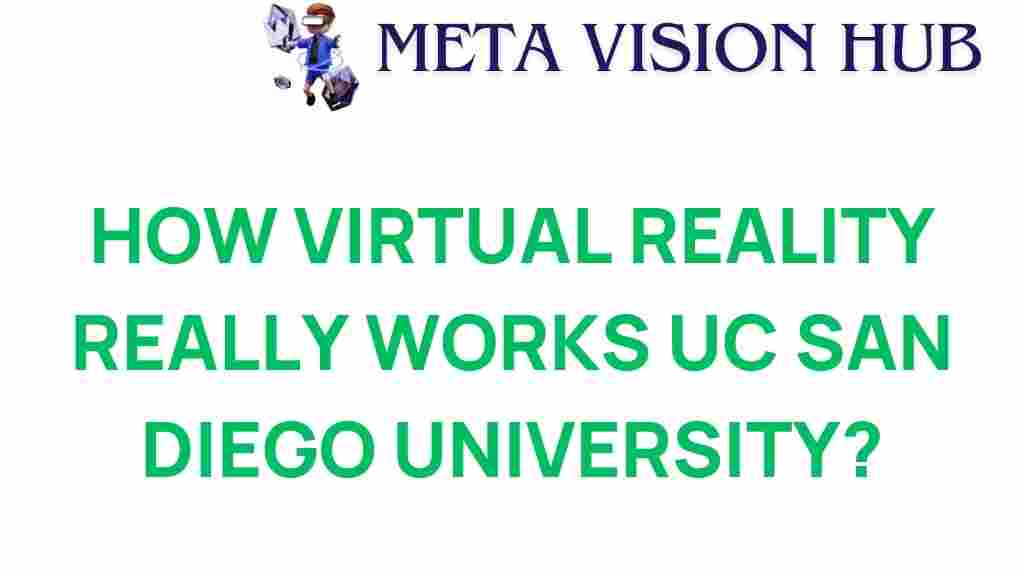Unveiling the Mysteries: How Virtual Reality Works at UC San Diego
Virtual reality (VR) is revolutionizing the way we interact with digital environments, and at UC San Diego, it is at the forefront of innovation and research. This article delves into the intricate workings of virtual reality technology and how it is being harnessed to create immersive experiences that transform education and research. Whether you’re a tech enthusiast or a student looking to explore the capabilities of VR, understanding its applications at UC San Diego is essential.
The Basics of Virtual Reality
At its core, virtual reality is an advanced computer-generated simulation that allows users to experience and interact with a three-dimensional environment. By utilizing specialized hardware and software, users can immerse themselves in these digital spaces, making VR a powerful tool for education, research, and entertainment.
The technology behind virtual reality operates through the following key components:
- Head-Mounted Displays (HMDs): These devices, such as the Oculus Rift or HTC Vive, provide the visual component of VR, allowing users to see and interact with the virtual world.
- Motion Tracking: Sensors and cameras track the user’s movements, allowing for real-time interaction within the VR environment.
- Sound and Haptics: Immersive audio and tactile feedback enhance the realism of the experience, making it more engaging.
The Role of UC San Diego in VR Research and Innovation
UC San Diego stands out as a leader in the realm of virtual reality, with a dedicated focus on research and innovation in VR technology. The university’s commitment to pushing the boundaries of what is possible in digital environments has led to groundbreaking advancements. Here’s how UC San Diego is making an impact:
- Interdisciplinary Research: Researchers from various fields collaborate to explore the potential of VR in areas such as cognitive science, engineering, and social sciences.
- Educational Applications: VR is being integrated into the curriculum, providing students with immersive learning experiences that enhance understanding and retention of complex subjects.
- Community Engagement: UC San Diego actively engages with the community to promote the benefits of VR technology, hosting events and workshops to showcase its applications.
Creating Immersive Experiences at UC San Diego
The creation of immersive experiences in virtual reality requires a combination of creativity, technology, and user interaction. UC San Diego leverages cutting-edge technology and innovative design principles to craft these experiences.
Step-by-Step Process of Crafting VR Experiences
Here’s a simplified overview of how immersive VR experiences are developed at UC San Diego:
- Concept Development: Ideas are generated based on research needs or educational goals, focusing on how VR can fulfill specific objectives.
- Content Creation: Artists and developers collaborate to create 3D models, animations, and environments that will populate the VR experience.
- Programming and Integration: Software engineers program interactions and integrate the content into a VR platform, ensuring that it works seamlessly with the hardware.
- User Testing: Prototypes are tested with real users to gather feedback and refine the experience based on usability and engagement.
- Implementation: The final product is deployed for educational use, research, or community engagement, allowing users to explore and interact with the virtual environment.
Virtual Reality in Education at UC San Diego
One of the most exciting applications of virtual reality at UC San Diego is its integration into educational programs. By providing immersive experiences, VR enhances learning outcomes and engagement in various subjects.
- Science and Engineering: Students can conduct virtual experiments, explore complex systems in 3D, and visualize scientific concepts in a way that traditional methods cannot achieve.
- Humanities: Virtual reality allows students to experience historical events or cultural artifacts in a more impactful way, fostering a deeper understanding of context and significance.
- Healthcare Education: Medical students can practice surgical procedures or patient interactions in a safe, controlled environment, honing their skills without risk.
Challenges and Troubleshooting in VR Experiences
While virtual reality offers incredible opportunities, there are challenges that can arise during the development and use of VR experiences. Here are some common issues and troubleshooting tips:
- Motion Sickness: Some users may experience discomfort when using VR. To mitigate this, ensure that the environment is stable and avoid rapid movements.
- Technical Issues: Hardware or software malfunctions can disrupt the experience. Regular maintenance and updates can help prevent these problems.
- User Interface Confusion: Make sure the user interface is intuitive. Conduct user testing to identify areas where users may struggle and make adjustments accordingly.
By addressing these challenges, UC San Diego continues to refine its VR experiences, ensuring that they are accessible and enjoyable for all users.
Future of Virtual Reality at UC San Diego
As technology evolves, so too does the potential for virtual reality. UC San Diego is poised to remain at the cutting edge of VR research and education, exploring new applications and techniques that can further enhance immersive experiences.
- Advancements in Hardware: As VR hardware becomes more advanced and affordable, more students and researchers will have access to these powerful tools.
- Integration with AI: The combination of VR and artificial intelligence could lead to even more personalized and adaptive learning experiences.
- Expanded Applications: Beyond education and research, we can expect to see VR being utilized in areas such as mental health therapy, training simulations, and remote collaboration.
Conclusion
Virtual reality is an exciting frontier in technology, offering immersive experiences that change the way we learn and conduct research. At UC San Diego, the exploration of VR is paving the way for innovative educational practices and groundbreaking research. As we continue to unveil the mysteries of virtual reality, the potential applications are limitless, promising a future where digital environments play an integral role in our everyday lives.
For more information about UC San Diego’s initiatives in virtual reality, visit their official page. To learn more about general VR technology, check out this resource for insights and news in the VR space.
This article is in the category ImmersiveTech and created by MetaVisionHub Team
